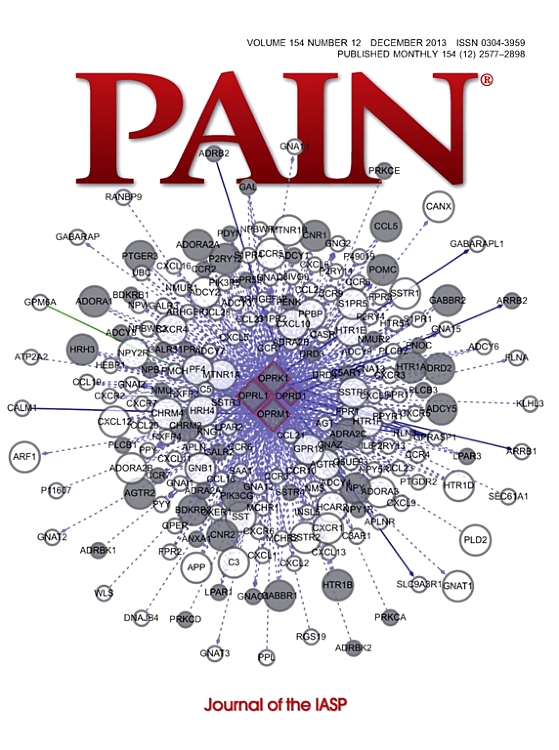健康青春期少女的雄激素水平与实验性疼痛敏感性
IF 5.9
1区 医学
Q1 ANESTHESIOLOGY
引用次数: 0
摘要
根据动物和成人的研究,雄激素,如睾酮,具有抗伤害感受作用。然而,由于雄激素在青春期可能发挥不同的生理作用,目前尚不清楚是否也会在青少年中发现抗伤害感受作用。因此,本研究考察了健康青春期女孩的睾丸激素水平与实验性疼痛敏感性之间的关系。此外,实验疼痛敏感性与其他雄激素,包括脱氢表雄酮(DHEA),脱氢表雄酮硫酸酯(DHEA- s),二氢睾酮和雄烯二酮之间的关系进行了探讨,并测试了青春期在调节这些关系中的作用。45名健康女孩(11.91±1.35岁)完成了热、冷、压痛阈值、热、冷痛强度评分、时间总和、热、压条件疼痛调节、补偿镇痛和冷痛耐受性的综合心理物理评估。采集血液样本分析性激素水平。参与者还完成了青春期发展量表。相关性和回归模型检验了雄激素和实验疼痛敏感性之间的关系,以及青春期是否调节了这些关系。总的来说,睾酮、DHEA、DHEA- s、双氢睾酮或雄烯二酮水平与实验疼痛敏感性之间没有明显的关联,这些关联也没有因青春期而减弱。DHEA-S水平仅与冷痛阈值和耐受性相关,青春期阶段调节了DHEA-S与冷痛耐受性的关系,且仅在青春期晚期组(r = 0.453, P = 0.027)显著,而在青春期早中期组不显著。这项研究的结果表明,雄激素可能对健康的年轻青春期女孩的实验性疼痛敏感性有最小的影响。本文章由计算机程序翻译,如有差异,请以英文原文为准。
Androgen levels and experimental pain sensitivity in healthy young adolescent girls.
Androgens, such as testosterone, have an antinociceptive effect based on animal and adult studies. However, because androgens may exert different physiological effects during puberty, it is not clear whether the antinociceptive effect would also be found in adolescents. Thus, this study examined the relationships between testosterone levels and experimental pain sensitivity in healthy young adolescent girls. In addition, the relationships between experimental pain sensitivity and other androgens, including dehydroepiandrosterone (DHEA), dehydroepiandrosterone-sulfate (DHEA-S), dihydrotestosterone, and androstenedione, were explored, and the role of puberty in moderating these relationships was tested. Forty-five healthy girls (11.91 ± 1.35 years) completed comprehensive psychophysical assessments of heat, cold, and pressure pain thresholds, heat and cold pain intensity ratings, temporal summation, heat- and pressure-conditioned pain modulation, offset analgesia, and cold pain tolerance. Blood samples were collected to analyze sex hormone levels. Participants also completed the Pubertal Developmental Scale. Correlations and regression models examined the associations between androgens and experimental pain sensitivity, and whether pubertal stage moderated these relationships. Overall, no significant associations were found between levels of testosterone, DHEA, DHEA-S, dihydrotestosterone, or androstenedione and experimental pain sensitivity, nor were these associations moderated by pubertal stage. Only DHEA-S levels were related to cold pain threshold and tolerance, and pubertal stage moderated the relationship between DHEA-S and cold pain tolerance, which was significant only in the late (r = 0.453, P = 0.027) but not early-mid puberty group. The results of this study suggest that androgens may have a minimal effect on experimental pain sensitivity in healthy young adolescent girls.
求助全文
通过发布文献求助,成功后即可免费获取论文全文。
去求助
来源期刊

PAIN®
医学-临床神经学
CiteScore
12.50
自引率
8.10%
发文量
242
审稿时长
9 months
期刊介绍:
PAIN® is the official publication of the International Association for the Study of Pain and publishes original research on the nature,mechanisms and treatment of pain.PAIN® provides a forum for the dissemination of research in the basic and clinical sciences of multidisciplinary interest.
 求助内容:
求助内容: 应助结果提醒方式:
应助结果提醒方式:


